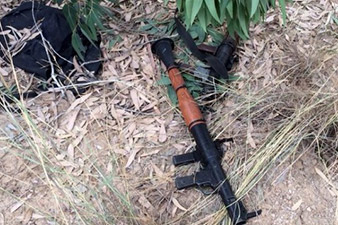
21/07/2014 10:52
How Hamas uses its tunnels to kill and capture Israeli soldiers
It was a Monday in October 2013 when residents of a kibbutz called Ein Hashlosha just east of the Gaza border heard strange sounds.
It was difficult to pinpoint the source. The sounds weren’t coming from above ground — but beneath it. The Israeli Defense Forces (IDF) soon discovered the source of the sounds was an “extremely advanced and well prepared” tunnel.
Not only was the burrow remarkable in depth, width and length – 1.5 miles long and 66 feet underground – it was equipped with electricity and contained enough cookies, yogurt and other provisions to last its occupants several months. Israeli forces estimated Hamas had dumped $10 million and 800 tons of concrete into the two-year project.
Such “terror tunnels,” the Israeli military said in a statement on Friday, are “complex and advanced.” And their use, Israel said, is “to carry out attacks such as abductions of Israeli civilians and soldiers alike; infiltrations into Israeli communities, mass murders and hostage-taking scenarios.”
Describing the emerging “tunnel war,” a Palestinian militia document obtained by Al-Monitor said the objective of the underground network was “to surprise the enemy and strike it a deadly blow that doesn’t allow a chance for survival or escape or allow him a chance to confront and defend itself.”
On Saturday morning, in what The Washington Post called an “audacious attack,” Hamas fighters wearing Israeli army uniforms infiltrated central Gaza through a tunnel and attacked an Israeli army patrol, killing two Israeli soldiers. In a second attempt Saturday to enter Israel through their tunnels, the Post reported, Hamas militants were found carrying handcuffs and tranquilizers in an apparent attempt to kidnap soldiers, Israel’s military said, adding that the militants were killed. In a third incident, a militant emerged from a concealed tunnel entrance in southern Gaza and began firing at soldiers.
And early Monday, a spokesman for the Israeli military said that two “terrorists squads” had infiltrated Israel through a tunnel from northern Gaza. Israeli aircraft hit one group; a second fired an anti-tank missile at an army vehicle before ten of them were killed by return fire.
“We’ve expanded the forces on the ground in order to accomplish that mission,” said Capt. Eytan Buchman, an Israeli military spokesman. “All of Gaza is an underground city, and the amount of infrastructure Hamas built up over the years is immense. There are tunnels, extended bunkers, weapons storage facilities, even within urban areas.”
Analysts said the tunnels are a major prong of Hamas’s military strategy against Israel. So far, the IDF has sussed out 36 of what it calls “terror tunnels,” but there are likely more. While the Gaza Strip remains mired in poverty — the 2011 per capita income was $1,165 — Hamas is believed to have sunk more than $1 million into the maintenance of every tunnel.
One tunnel digger, who says workers stay underground for long periods of time, explained how they’re constructed. “The drilling is done via a mechanical device, not an electric one, to avoid making noise,” he said. “It uses a [pedal-powered] chain, similar to a bicycle chain. [The chain] moves metal pieces that dig through the dirt. During the digging, the digger lies on his back and pedals with his feet.” The tunnels are high enough to walk through standing up and reinforced by concrete.
“Much to the misfortune of the people of Gaza, Hamas has invested far more resources in ‘underground Gaza’ than in ‘upper Gaza,’” wrote Al-Monitor’s Shlomi Eldar. “The ‘change and reform’ that Hamas offered its voters was invested in its tunnels at the expense of the people of Gaza.”
If the tunnels are a result of Hamas’s 2006 election, the group got down to business almost immediately. That year Hamas used a tunnel to capture Israeli soldier Gilad Shalit in June. One early morning, according to Haaretz, militants crossed underneath the Gaza border and attacked Shalit’s guard tower at 5:13 a.m. Within six minutes, the attackers had secreted Shalit back across the border in a tunnel — and he wasn’t returned to Israel for five years.
In the years since, Hamas’s tunnels could rival those used by the Vietcong during the Vietnam War. Communist guerrilla fighters were said to have constructed miles of tunnels in the region around Saigon, then the capital of South Vietnam.
One reason for tunnels, Eldar wrote in a separate article, is to keep soldiers occupied during a period of relative peace. “What do you do with thousands of motivated, armed men with the urge to fight?” he said. “You come up with some operational occupation. Digging an underground tunnel.”
There are three types of tunnel, he said. The first are economic: hundreds of tunnels burrowing into Egypt, which allowed Hamas to funnel in resources, guns and rockets until many were sealed off by the Egyptians.
Another set of tunnels reportedly services the Hamas high command. “Every single leader of Hamas, from its lowest ranking bureaucrats to its most senior leaders, is intimately familiar with the route to the security tunnel assigned to him and and his family,” reported Al-Monitor. The most senior leadership has its own specific tunnel.”
The last kind plagues Israel: tunnels under the Gaza border. Closing down that network is one of the current invasion’s top priorities.








